What Do Different Cat Sleeping Positions Mean?

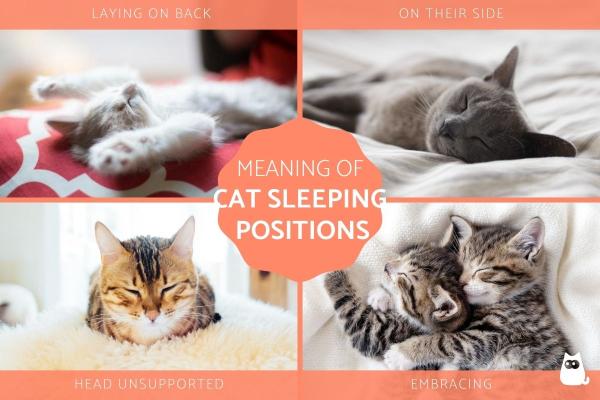

See files for Cats
Cats are world-champion sleepers. While it will depend on their age and health status, cats will sleep an average of 13 to 20 hours per day. The type of sleep will vary with some periods of light dozing and others of REM deep sleep. However, there are many factors which affect the quality of their sleep, something we can tell by their different sleeping positions.
At AnimalWised, we ask what do different cat sleeping positions mean? We look at the meaning of the most common sleeping cat poses and find out what they can tell us about the health and well-being of the feline.
- In a ball covering their head
- Stretched out
- Laying on their back
- Lying on front with head unsupported
- Lying on front with head supported
- Laying on their side
- Covered
- In an embrace
- Sleeping positions of young kittens
- Other sleeping poses of cats
1. In a ball covering their head
This cat sleeping position is related to their wild ancestry. Wild cats don't have the luxury of a roof over their head, so they have to find shelter where they can. Sometimes, this will mean they will have to be their own shelter. By curling up into a ball, they can conserve their body heat and protected their internal organs from the wind. By covering their heads with their paws, they will feel even more protected.
Domestic cats may be able to stay better protected within the home, but they will still roll up into a ball. This could be to protect themselves against a chill in the air or simply because this cat sleeping position indicates they want to feel comfortable.

2. Stretched out
During the warm summer months, cats often sleep stretched out on the ground. If you find your cat sleeping stretched out and they suddenly stretch out to twice their size, they may simply be trying to cool off. This is because the ground may not have warmed up yet and provides some refreshment. It's like their ‘cool side’ of the pillow. Also because increasing their body surface acts in the opposite way of curling up.
Stretching may also be a practical since their muscles can tighten from stress or exercise and stretching helps to relax them.
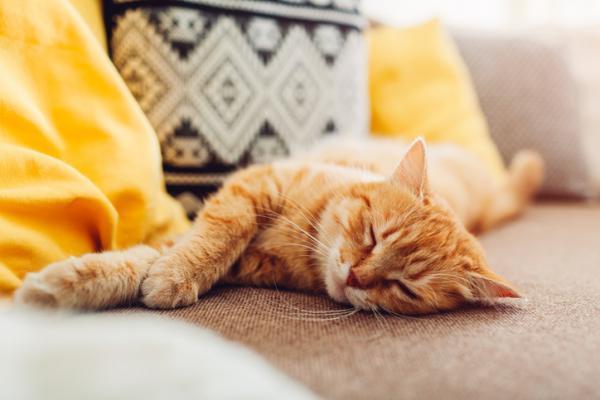
3. Laying on their back
Cats which feel very comfortable in their home means they trust they are safe in their environment. Since they have security, they can allow themselves to rest in sleeping positions where they are more vulnerable. Laying on their back is perhaps the most vulnerable position they can be in, especially when their head is laid back. Their underside is the most vulnerable part of their body, so laying with it exposes would be dangerous in the wild.
When cats are kittens, they are more likely to sleep in this position. However, once they get older, it is possible they will become more cautious and won't sleep like this often. This is especially the case if they live with other animals or have any reason to feel insecure in the home. Also, this can change depending on the circumstances of the home.
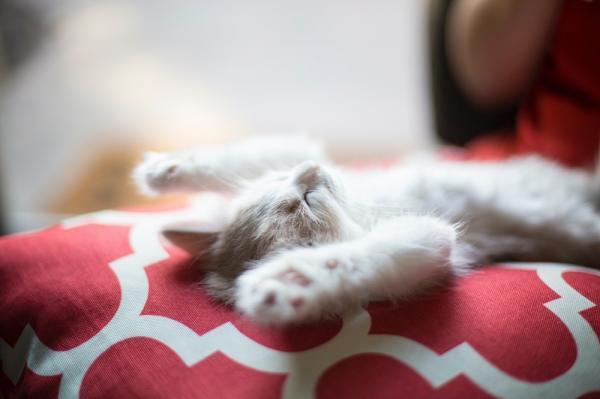
4. Lying on front with head unsupported
In this feline sleeping position, the cat is laying on their belly with their paws together and their head unsupported. Often the cat will have their ears tucked back and they face away from their guardian. Although the cat's eyes are closed, they are not in a deep sleep. They are usually still quite alert and simply having a doze to help them conserve energy. They may still be listening to their surroundings and will be able to move at a moment's notice.
This cat sleeping position might indicate the cat feels insecure. It is often seen in cats which are new to a home and are not yet completely comfortable. It may also be a sign the cat is having trouble sleeping, either due to stress or sickness. If this happens frequently and you see other symptoms, take the cat to a veterinarian.

5. Lying on front with head supported
Of all the positions cats take to sleep this is one of the most common and perhaps the most ambiguous. They may not be able to assess whether the situation and environment are safe, but they also might be tired so they can't support their head. This means they are likely confident they are safe, but they are being careful not to sleep heavily.

6. Laying on their side
When a cat sleeps on their side, their body language is telling us they are feeling happy and carefree. Sleeping on their side allows a cat to recuperate and is another of the most common sleeping positions for cats. Since they are able to recharge, they can get comfortable and stretch their legs out. This not only gives their mind a rest, but it helps their muscles to stay in condition so they can be active as soon as they finish their snooze.
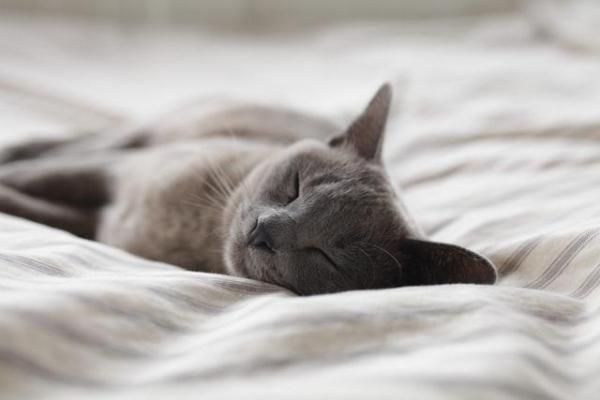
7. Covered
Cats love finding hiding places to sleep. These might be in the clothes cupboard, in a drawer, on top of the refrigerator or even in a discarded cardboard box. This is also due to their ancestral instinct since these places are hidden away and, often, hard to access. Sleeping in such places helps to keep them covered from perceived threats and provides them with a feeling of security. Although it won't necessarily mean they are stressed, we should consider the possibility if the cat sleeps covered all the time.
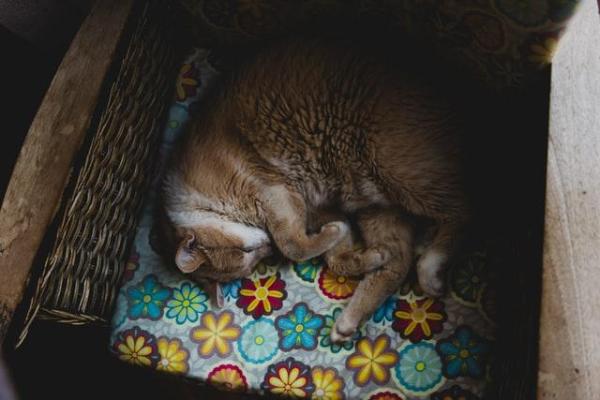
8. In an embrace
When two or more cats live together, undoubtedly the most adorable sleeping position of cats is when they are hugging each other in an embrace. Animals will have practical reasons for doing this. If the air is cold, sleeping close together allows them to conserve body heat.
However, cats sleeping in an embrace also reveals an important emotional factor about their well-being. It means the cats trust each other and feel completely safe and happy. The reason why we find it so adorable is because we recognize the love and affection they are showing to each other, one of the many ways cats show affection.
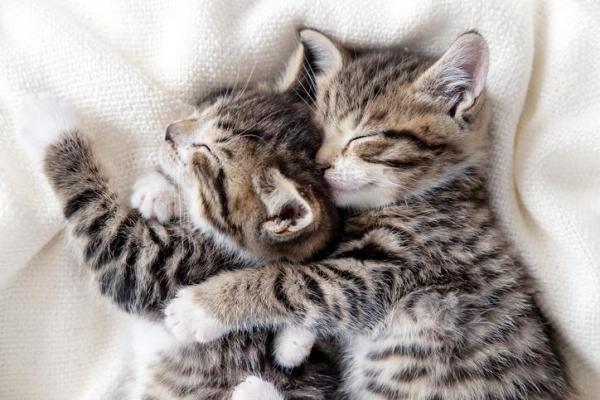
Sleeping positions of young kittens
In young kittens, all kinds of sleeping postures can be observed. Kittens usually sleep in a totally relaxed way. One moment they are suckling on their mother's teat and the next they have fallen asleep in the most comfortable position you can find. This is usually with all four legs stretched out in all directions.
Slightly older kittens, often just fall asleep where they are in a given moment. Often these lead to the weirdest and funniest poses you've ever seen. Completely exhausted and tired, kittens fall asleep, sitting, leaning on a piece of furniture, face up, with their head hanging from the sofa or their legs raised. While it can't seem comfortable, it simply shows they are carefree and happy.
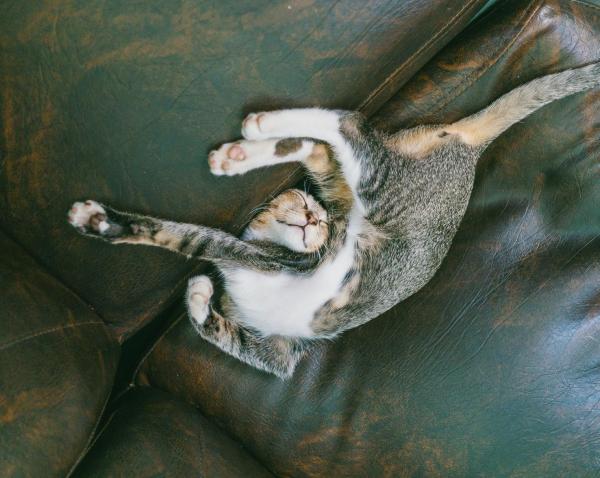
Other sleeping poses of cats
As we have seen above, a cat's sleeping positions are highly dependent on their well-being and feeling of security. However, we cannot take every sleeping position and assume they are chronically feeling a certain way. A cat's mood is variable. Changes in their environment and even physical changes in their body can make them change how they sleep.
One of the important factors about our cat is whether or not they sleep with you. If a cat is comfortable with us and has a strong bond, they will feel comfortable being next to us. They may even sleep on top of us. If this is the case, we should feel glad and confident that we have a strong relationship with a cat who feels loved and secure when with us.

If you want to read similar articles to What Do Different Cat Sleeping Positions Mean?, we recommend you visit our Facts about the animal kingdom category.














